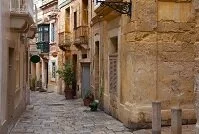It was the 1500s when architecture truly began to blossom in Valletta. During this time numerous buildings in various styles were built, most prominently in the Renaissance, Baroque, and Rococo styles. The Grandmaster's Palace (1571-1574; now Malta's House of Representatives) and the Mediterranean Conference Centre (1574), both in Valletta, are two of the most impressive Renaissance buildings in the country. St. Johns Co-Cathedral (1573-1578) was also built by the powerful Knights of Malta Order in the Baroque style, but with Byzantine influences. The National Museum of Fine Arts (1570s), again in the capital, is in the late Baroque, or Rococo style.

Street in Vittoriosa
Most of the architecture built since the golden age in the 1500s has been either destroyed or, more likely, restored in recent times. Perhaps the best example of this is the Valletta Waterfront, which was originally constructed as nineteen different buildings, primarily built in the 1600s. It was recently renovated and these buildings were united to create a present-day construction that is very representative of the country's architectural history.
Today, much of Valletta remains in the simple stone style, however interiors and even exteriors have been remodeled to make the buildings useful for today's demands. Valletta, above all other locations in Malta, is the best representative of the country's architecture and is one of the most densely represented architectural cities in the world.